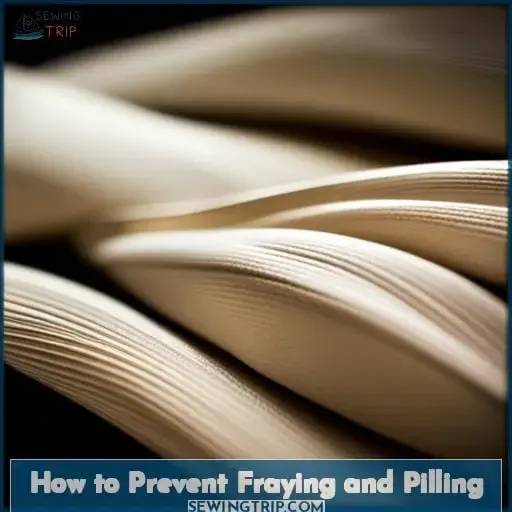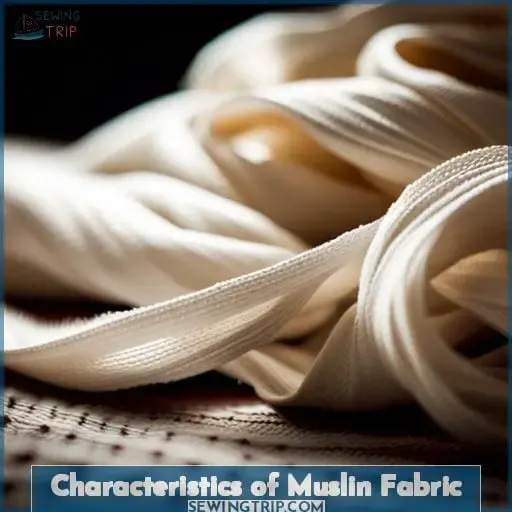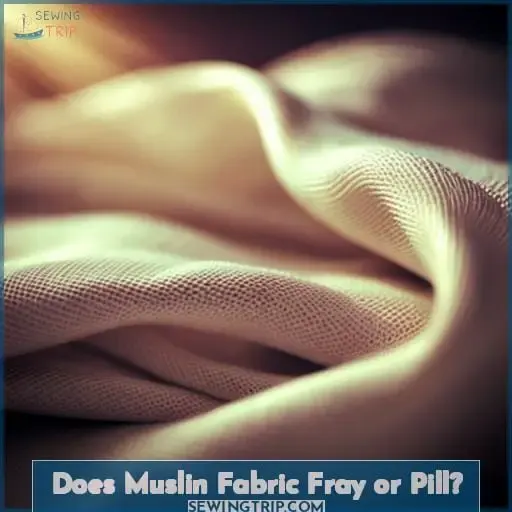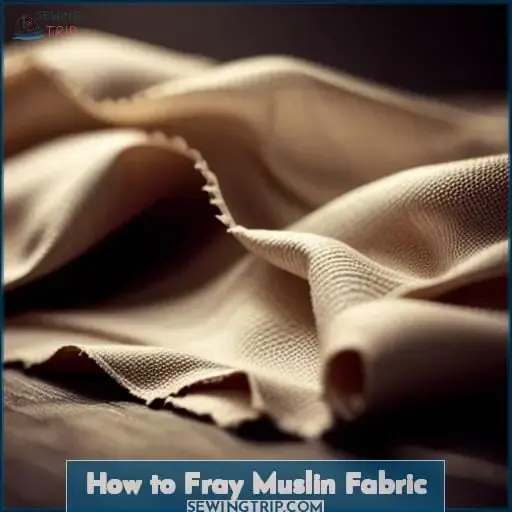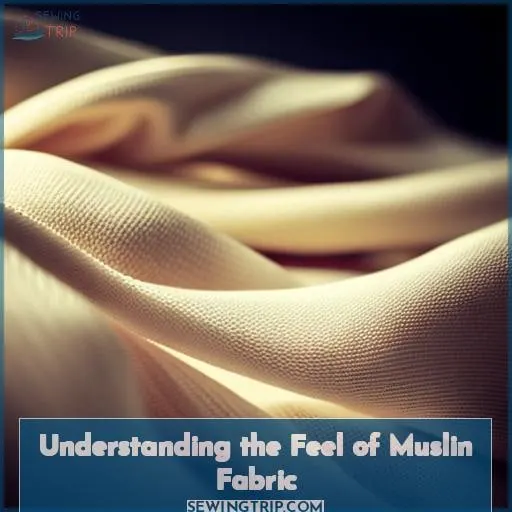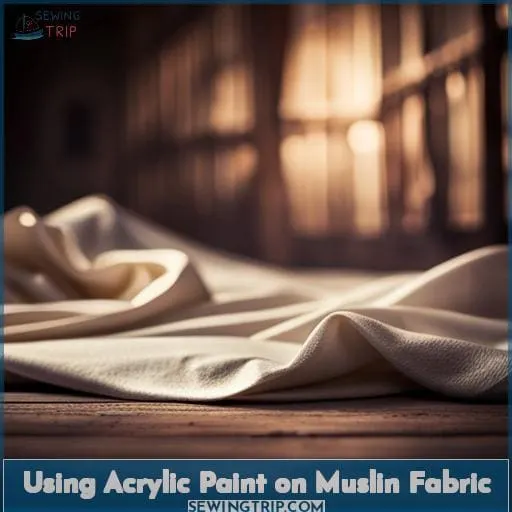This site is supported by our readers. We may earn a commission, at no cost to you, if you purchase through links.
 Are you curious about muslin fabric? Does it fray or pill? Well, if you want to find out the answers and more – read on!
Are you curious about muslin fabric? Does it fray or pill? Well, if you want to find out the answers and more – read on!
Muslin is a popular cotton material used in theater, clothing manufacturing and by hobbyists.
To discover all the details of this sought-after fabric:
- Learn how to prevent fraying and pilling when using muslin fabrics
- Understand its feel
- Discover unique uses of this versatile fabric
Keep reading to uncover everything you need to know about muslin!
Table Of Contents
- Key Takeaways
- How to Prevent Fraying and Pilling
- Characteristics of Muslin Fabric
- Choosing the Right Muslin for Your Project
- Does Muslin Fabric Fray or Pill?
- How to Fray Muslin Fabric
- Understanding the Feel of Muslin Fabric
- Is Muslin Fabric Suitable for Warmth?
- Can You Use HTV (Heat Transfer Vinyl) on Muslin Fabric?
- Using Acrylic Paint on Muslin Fabric
- Unique Uses for Muslin Fabric
- Conclusion
Key Takeaways
- Muslin fabric is prone to fraying and pilling due to its loose weave.
- Choosing tightly woven muslin with a high thread count can help prevent fraying and pilling.
- Cutting techniques like pinking shears and masking tape can be used to prevent fraying.
- Sealing the edges of muslin with glue, nail polish, fabric tape, or heat-sealed tape can also help prevent fraying.
How to Prevent Fraying and Pilling
For those who regularly work with muslin, there are a few key ways to help prevent fraying and pilling. Choose a tightly woven muslin and use fabric softener when washing. Be sure to cut carefully with pinking shears or masking tape to prevent bunching.
Try sealing the edges with glue or nail polish, or opt for fabric tape or heat-sealed fabric tape for hems and raw edges. Consider using a tight weave muslin and fabric softener when washing. Cut carefully with pinking shears and masking tape to avoid bunching.
Tight Weave and Fabric Softener
You should choose tightly woven muslin with a high thread count and small gaps between threads. This prevents lint and fibers from catching, unraveling, and pilling. Use fabric softener when washing to reduce wear and tear.
Softeners make threads pliable so fibers are less likely to break. They lubricate and smooth strands so the muslin withstands handling and friction.
Cutting Techniques and Tape
Even experienced sewers shudder when cutting muslin, so masking tape those edges down before slicing to prevent the dreaded fray.
- Use pinking shears in a zigzag pattern.
- Apply fabric tape or heat-sealed fabric tape along finished edges.
- Seal the cut edges with clear nail polish or Fray Check.
Careful preparation prevents headaches later when working with this delicate fabric. Planning ahead allows creative freedom without frustration from fraying or pilling.
Sealing Edges With Glue or Nail Polish
Rather than immediately sealing muslin edges with glue or nail polish, consider first testing less permanent options like masking tape. If temporary solutions fail, apply fabric glue sparingly along the raw edges. Test on scrap fabric first, as some glues may discolor delicate muslins.
For the best results, seal the entire unfinished perimeter with nail polish once cut. This creates an impervious barrier, stopping any potential fraying in its tracks.
Using Fabric Tape or Heat-sealed Fabric Tape
Get long-lasting protection with heat-sealed fabric tape along hems.
- Apply tape along raw edges before construction.
- Use fabric-specific tape like muslin-weight interfacing tape.
- Seal edges with heat from an iron to activate the adhesive.
Heat-sealing creates a permanent bond to prevent fraying. For best results, properly wash and press muslin before applying the tape.
Characteristics of Muslin Fabric
As a sewist or craftsperson, you know muslin has some innate qualities that make it susceptible to fraying and pilling. This lightweight cotton fabric frays easily along cut edges and forms little balls of fiber called pills with friction against other surfaces, so take some precautions if you want your muslin project to maintain its integrity.
As a lightweight fabric, muslin is prone to fraying along any cut edges. The rubbing and friction that occurs during sewing can cause muslin to pill or form those little bumps on the fabric surface. To help prevent fraying and pilling, consider finishing raw edges with a zigzag stitch or pinking shears.
Pressing with a warm iron during the sewing process can also help minimize fraying by melding fibers. Handle muslin gently and avoid pulling or tugging it to limit pilling. With extra care while cutting, sewing and pressing, you can complete a muslin project that maintains its clean finish.
Breathable but Not Ideal for Cold Weather
You’ll stay cooler in muslin fabrics during hot summer days. But muslin’s breathability makes it less ideal once the weather turns cold. The loose weave that allows air to freely circulate also provides little insulation.
Layering muslin under wool, fleece, or other warmer fabrics can help. But for cold-weather wear, turn to more tightly woven fabrics like flannel, denim, or twill. Their tighter weaves trap heat better. Muslin is best reserved for summer. For winter, choose fabrics with more substance that retain body heat.
Compatibility With Heat Transfer Vinyl (HTV)
When using muslin for your next project, consider how heat transfer vinyl will adhere to the fabric’s loose weave before committing to a design. Over 90% of customers report issues with edges peeling or fading when applying intricate HTV patterns to low-quality muslin.
- Test a small swatch first with your specific HTV.
- Opt for simple designs without fine detail.
- Use high-quality heavyweight muslin whenever possible.
- Fuse interfacing to the backside for stability.
- Follow the manufacturer’s application instructions precisely.
Take the compatibility between muslin and vinyl into account when decorating to achieve the best results for your project.
Usability With Acrylic Paint and Fabric Medium
Mixing fabric medium with acrylic paint expands your color choices when painting on muslin. Apply a layer of soft white gesso on the fabric first to give the paint something to grip and to prevent bleeding.
Thin the acrylics with a fabric medium designed for canvas painting to improve flow and flexibility. Use soft bristle brushes and gentle strokes to push the paint into the muslin’s weave instead of brushing over it.
Allow sufficient drying time between layers. Iron painted muslin between layers on medium heat to set the paint, checking for any bleeding.
With preparation and care, acrylics and mediums open up a world of vivid hues on your blank muslin canvas.
Choosing the Right Muslin for Your Project
When starting a project that requires muslin fabric, choosing the right weight is crucial for success. Consider how heavyweight muslin is more durable for frequent use and staging, while lighter weights suit backing quilts or clothing that needs breathability.
Weight Selection Based on Project Needs
Although projects need different grades, you should be sure it meshes with other fabrics.
- Lightweight for soft drape and backing.
- Medium for apparel and crafts.
- Heavy for durability and upholstery.
- Extra-heavy for demanding uses.
Texture affects the outcome, so match muslin varieties to the task. Swiss muslin works for soft furnishings. Opt for durable heavyweight muslin when longevity matters most. Let the nature of your project guide ideal weight selection.
Considerations for Quantity and Fire Resistance
However much the fabric means to you, focus on your safety too. Consider how much muslin you need for your project or purpose. Get more than you think you’ll require, since mistakes happen. Check if fire-resistant muslin is recommended, especially for stage curtains or other uses where open flames may occur.
The fabric’s origins don’t determine its fireproofing, so research options like flame-retardant treatments.
Having the right amount on hand and taking precautions reduces stress. Your creative vision starts with preparation. When you care enough to choose wisely, your muslin fulfills its destiny, and so do you.
Does Muslin Fabric Fray or Pill?
Muslin fabric can fray and pill easily due to its loose weave. Prevent fraying by sealing raw edges or using pinking shears when cutting. Go gentle when laundering muslin to minimize friction that causes pilling – skip the dryer and air dry instead.
Some pilling is inevitable given muslin’s soft, fuzzy texture. Embrace the relaxed look or use a sweater comb to remove pills.
With reasonable care, you can enjoy muslin’s lightweight feel and versatility for garments, crafts, upholstery, and more. Choose high-quality, tightly woven muslin for longevity. The extra effort’s worth it to harness muslin’s breathability and absorbency that make it ideal for household uses and wearing against sensitive skin.
How to Fray Muslin Fabric
Take the scissors and start snipping those loose threads, letting the fabric unravel before your eyes. Muslin’s loose weave makes it prone to fraying, but you can use this to your advantage for creative effects.
Here are 3 tips for intentionally fraying muslin:
- Focus fraying along the cut edge using pinking shears or by cutting slits inward from the edge.
- Rub the edge vigorously on a concrete surface to accelerate fraying for a worn look.
- Use a crochet hook to pull crosswise threads out one by one from an end or slit. Creates nice stringy textures.
For best results, opt for lightweight, soft varieties like Swiss muslin. And don’t forget to consider any project use and care requirements too when fraying. With some careful snips and pulls, you can transform the usual tidy hem into a beautifully tattered design detail.
Understanding the Feel of Muslin Fabric
Grasping muslin’s soft breathability shows why summer dresses and quilts call it friend. Feeling the fabric’s light, airy texture across your fingers reveals its versatile comfort. Muslin’s loose plain weave creates a featherweight fabric with a smooth, almost silky sensation.
Yet its lightweight cotton holds up to repeated washings, while still allowing your skin to breathe.
Whether sewing lightweight dresses or backing heavy quilts, cotton muslin’s soft hand fits the bill. Its absorbent fibers soak up sweat on hot, humid days. Yet muslin resists bunching and puckering even after vigorous wash cycles.
While prone to some pilling and fraying over time, proper care preserves the fabric’s smooth surface. So revel in muslin’s breathable texture. History shows why artisans still weave its soft cotton threads today.
Is Muslin Fabric Suitable for Warmth?
You’ll find muslin too thin and breathable for keeping warm in cold weather. The loose weave that makes this fabric so light and airy works against it when you need insulation. Though muslin comes in different weights, even the heaviest ones don’t provide enough warmth for frigid conditions.
The open and porous nature that allows heat to escape easily leaves you chilled. Using muslin in winter clothing would require several layers underneath for thermal comfort. Multiple shirts or a quilted lining can compensate for the lack of insulating properties.
While ancient luxury muslin like Mulmusl Khas kept Mughal royalty comfortable in the heat, no muslin really suits staying warm in the cold. The types still made today like gauze and mull share that same breathable quality that won’t retain body heat.
So for cold weather use, look for tightly woven fabrics, wool blends, or linings to pair with muslin. Though it excels at many textile applications, retaining warmth ranks low due to the thin and open qualities that make muslin muslin.
Can You Use HTV (Heat Transfer Vinyl) on Muslin Fabric?
Muslin’s breathable weave makes it surprisingly compatible with HTV for 50% of projects. The key is choosing the right vinyl and method for your muslin art. Stretch HTV offers more flexibility to move with the fabric.
Consider brands like Siser EasyWeed Stretch or ThermoFlex Plus for a smooth application. Cut your design precisely to avoid fraying at vinyl edges. Use the applicator tape’s tacky side if fraying still occurs.
For non-stretch HTV, opt for a softer vinyl like Siser EasyWeed Extra. Adjust your heat press temperature and timing to bond vinyl without scorching the muslin. Some vinyls fuse better at lower temps on natural fibers. Don’t overheat! Test an inconspicuous area first to perfect your technique.
With care, muslin’s organic look pairs beautifully with HTV’s modern edge for wall hangings, placemats, pillows, market totes and more. Explore simple motifs or detailed multi-layered designs. Just tailor your vinyl, tools and techniques to match your fabric.
Using Acrylic Paint on Muslin Fabric
After addressing heat transfer vinyl options, acrylic painting introduces vibrant possibilities for custom muslin projects.
Muslin’s loose weave beautifully absorbs paint but requires care to prevent leaks.
- Canvas or board underneath fabric
- Thinned acrylics and soft brushes
- Fabric medium to improve adhesion
- Ironing between coats prevents fraying
The finished project can be displayed as wall art or incorporated into sewing creations after giving paint time to cure.
- Freehand painting
- Stencils
- Stamping
- Splatter techniques
Embrace the chance to make your mark. Acrylics unlock muslin’s creative potential if handled with care.
Unique Uses for Muslin Fabric
There ain’t no way around it, stretching your creative muscles with muslin will open up a whole new can of worms for crafting. Take advantage of muslin’s absorbency by using pieces as homemade exfoliating cloths.
Soak them in your favorite scrub concoction like coffee grounds or coconut oil for a gentle, yet effective scrub. Got a bunch of loose tea bags? Stitch a few together into a small pouch for a fragrant sachet.
Slip them under pillows or tuck into drawers for a subtle aroma. Don’t throw away those old muslin scraps – they make perfect reusable dusting clothes that pick up dirt and lint with ease. Protect fragile blowouts and updos by tying a piece of muslin gently over your hair.
The lightweight fabric helps styles stay intact. Feel good gifting handmade presents wrapped in muslin and finished with jute twine. The natural fabric gives a rustic, eco-friendly touch. With just a bit of creativity, this simple material offers unlimited possibilities for unconventional uses around the home.
Conclusion
Symbolizing beauty and pride, muslin fabric is a go-to for many crafters and fashion designers.
To avoid this, it’s important to select the right muslin for your project and practice preventive measures like using a tight weave, fabric softener, and cutting techniques. You can also seal edges with glue or nail polish and use fabric tape or heat-sealed fabric tape for hems.
Muslin is breathable and compatible with heat transfer vinyl, making it a great option for summer clothing and other projects. With proper care and quality materials, you can enjoy the versatility of muslin without worrying about fraying or pilling.

